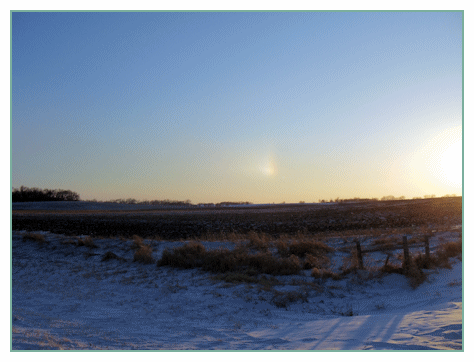sundogs

A luminous spot occasionally seen a few degrees from the sun, supposed to be formed by the intersection of two or more halos, or in a manner similar to that of halos. — Webster, 1882
 “A wonderful lunar display was seen Thursday evening. The moon was surrounded by a bright halo, and a perfect cross extended across the center, each ray as far as the circle of light. Interesting study for anyone who wants to look it up.” – January 1884, De Smet Leader
“A wonderful lunar display was seen Thursday evening. The moon was surrounded by a bright halo, and a perfect cross extended across the center, each ray as far as the circle of light. Interesting study for anyone who wants to look it up.” – January 1884, De Smet Leader
 During the “first year” part of The First Four Years, Laura describes the children’s blizzard of January 1888, placing it earlier that it historically occurred by having it happen during the first year of her marriage to Almanzo Wilder, which took place in 1885. After the blizzard, Laura and Almanzo go outside into the “frosty air” late in the afternoon and see “huge sundogs” on either side of the sun.
During the “first year” part of The First Four Years, Laura describes the children’s blizzard of January 1888, placing it earlier that it historically occurred by having it happen during the first year of her marriage to Almanzo Wilder, which took place in 1885. After the blizzard, Laura and Almanzo go outside into the “frosty air” late in the afternoon and see “huge sundogs” on either side of the sun.
Sundogs – more properly called parhelia (singular is parhelion) – are caused by ice crystals in the viewer’s line of vision, and can occur with the sun or moon as it is viewed near the horizon, as when the Wilders were viewing the setting sun. Depending on the orientation of the main axis of falling hexagonal ice crystals, spots and/or a halo can be observed 22 degrees on either side of the sun (or moon) and at the same elevation as the sun (or moon). A reddish color is often seen on the side of the sundog closest to the sun, with blue visible on the side away from the sun. Sundogs most commonly appear during the winter in middle latitudes as spots of white and color on either side of the sun and sometimes as part of a visible halo that extends around the sun.
The photo above and on the navigation button that brought you to this page were taken by me in February 2015 just north of De Smet, South Dakota, when driving near the Wilders’ tree claim late in the evening. The photo shows one sundog to the south of the setting sun; the sun itself is on the right-hand side of the photo. There was another sundog to the north, but I wasn’t the only car on the road and couldn’t pull off due to snow and ice on the side of the road, so I had to act fast. They’re not the best photos, I know. If you want to see a brilliant display, check out THIS online photo. Amazing!
The following was written in 1887 by a New Englander describing sundogs to the folks back home: The winters, as everyone knows, are extremely cold, and many curious phenomena are seen in consequence… at sunset, the appearance of “sun-dogs” above and below the sun, and equidistant east and west from the sun sections of rainbows. This latter appearance is always followed by extreme cold weather.

sundog (FFY: The First Year)

